目录
set/multiset 容器
注意:set和multiset容器包含的头文件都是:#include
1 set基本概念
简介:
- 所有元素都会在插入时自动被排序(从小到大)
set容器的迭代器也不支持随机访问
本质:
- set/multiset属于关联式容器(特点是插入时自动被排序),底层结构是用二叉树实现。
set和multiset区别:
- set不允许容器中有重复的元素
- multiset允许容器中有重复的元素
2 set构造和赋值
功能描述:创建set容器以及赋值
构造:
set<T> st;//默认构造函数:set(const set &st);//拷贝构造函数
赋值:
set& operator=(const set &st);//重载等号操作符
#include<iostream>
using namespace std;
#include<set>
void test01() {
// 默认构造
set<int> s1;
// set容器插入数据只有insert这一种方式
s1.insert(11);
s1.insert(5);
s1.insert(0);
s1.insert(100);
s1.insert(100);
cout << "容器s1的内容如下:" << endl;
// 遍历容器
for (set<int>::iterator it=s1.begin();it!=s1.end();it++) {
cout << *it << " ";
}
cout << endl;
cout << "容器s1大小为:" << s1.size() << endl;
cout << "可以看到,我们像set容器里插入了5个数,其中有2个数相同,都为100" << endl;
cout << "但是最后只打印出了4个数据,且容器大小为4,不是5。" << endl<<endl<<endl;
// 拷贝构造
set<int> s2=s1;
cout << "s2拷贝自s1,s2的内容如下:" << endl;
for (set<int>::iterator it = s2.begin(); it != s2.end(); it++) {
cout << *it << " ";
}
cout << endl << endl;
set<int>s3 = s2;
cout << "s3=s2,s3里的内容如下:" << endl;
for (set<int>::iterator it = s3.begin(); it != s3.end(); it++) {
cout << *it << " ";
}
cout << endl << endl;
}
int main() {
test01();
cin.get();
return 0;
}
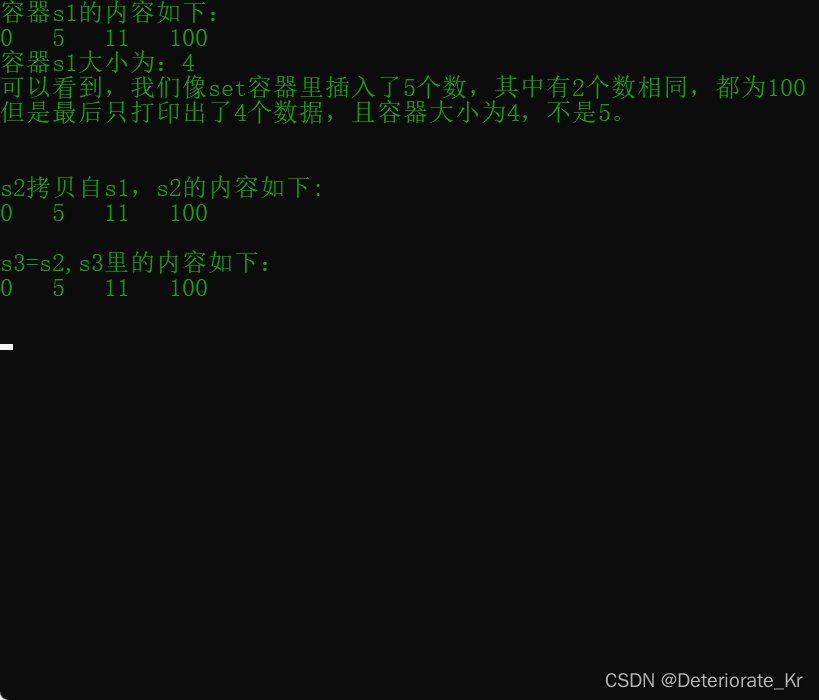
总结:
- set容器插入数据时只能用insert
- set容器插入数据的数据会自动排序
set容器不允许插入重复的数据,编译器不会报错。但是打印不出来,而且访问不到,相当于没插,容器里根本没这个重复的数。
3 set大小和交换
功能描述:
- 统计set容器大小以及交换set容器
set容器没有resize()调整大小函数
函数原型:
size();//返回容器中元素的数目empty();//判断容器是否为空swap(st);//交换两个集合容器
#include<iostream>
using namespace std;
#include<set>
// 打印函数
void printSet(set<int> s) {
for (set<int>::iterator it = s.begin(); it != s.end(); it++) {
cout << *it << " ";
}
cout << endl;
}
void test01() {
set<int> s1;
s1.insert(10);
s1.insert(20);
s1.insert(5);
s1.insert(26);
s1.insert(3);
cout << "s1交换前:" << endl;
printSet(s1);
if (s1.empty() == 1) {
cout << "set容器为空!" << endl;
}
else
{
cout << "set容器非空!!" << endl;
cout << "大小为:" << s1.size() << endl << endl;
}
set<int> s2;
cout << "s2容器交换前:" << endl;
s2.insert(0); s2.insert(0); s2.insert(1); s2.insert(4);
printSet(s2); cout << "s2的大小为:" << s2.size() << endl<<endl;
s1.swap(s2);
cout << "s1与s2交换后,s1变为:" << endl;
printSet(s1);
cout << "s1的大小:" << s1.size() << endl<<endl;
cout << "s2变为:" << endl;
printSet(s2);
cout << "s2的大小=" << s2.size() << endl;
}
int main() {
test01();
cin.get();
return 0;
}
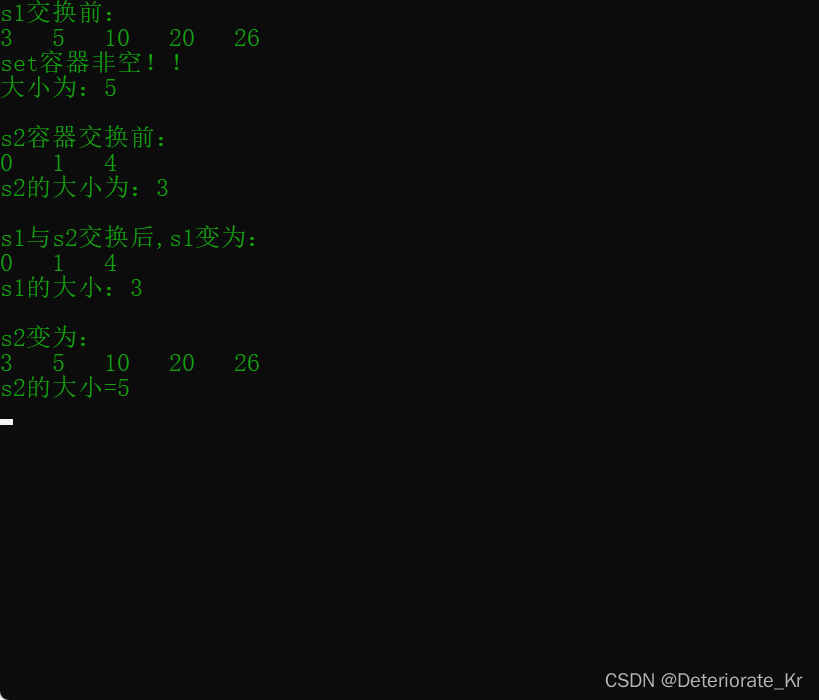
总结:
- 统计大小 — size
- 判断是否为空 — empty
- 交换容器 — swap
4 set插入和删除
功能描述:
- set容器进行插入数据和删除数据
set容器只有insert一种插入数据方式,而且不能指定位置。只能一个个地插,插入时数据自动被排序。不过set容器删除数据时可以指定位置
set容器的迭代器不支持随机访问
函数原型:
insert(elem);//在容器中插入元素。clear();//清除所有元素erase(pos);//删除pos迭代器所指的元素,返回下一个元素的迭代器。erase(beg, end);//删除区间[beg,end)的所有元素 ,返回下一个元素的迭代器。erase(elem);//删除容器中值为elem的元素。
#include<iostream>
using namespace std;
#include<set>
// 打印函数
void printSet(set<int> s) {
for (set<int>::iterator it = s.begin(); it != s.end(); it++) {
cout << *it << " ";
}
cout << endl;
}
void test01() {
set<int> s1;
s1.insert(10);
s1.insert(20);
s1.insert(5);
s1.insert(26);
s1.insert(3);
cout << "容器s1里的内容如下:" << endl;
printSet(s1);
cout << endl;
// 删除
// 注意set容器的迭代器不支持随机访问
s1.erase(s1.begin(), ++s1.begin());
cout << "删除s1容器里[s1.begin(),++s1.begint())这个区间的数据" << endl;
printSet(s1); cout << endl;
// 清空
s1.clear();
cout << "清空s1里的数据" << endl;
cout << "s1的大小为:"<<s1.size();
}
int main() {
test01();
cin.get();
return 0;
}
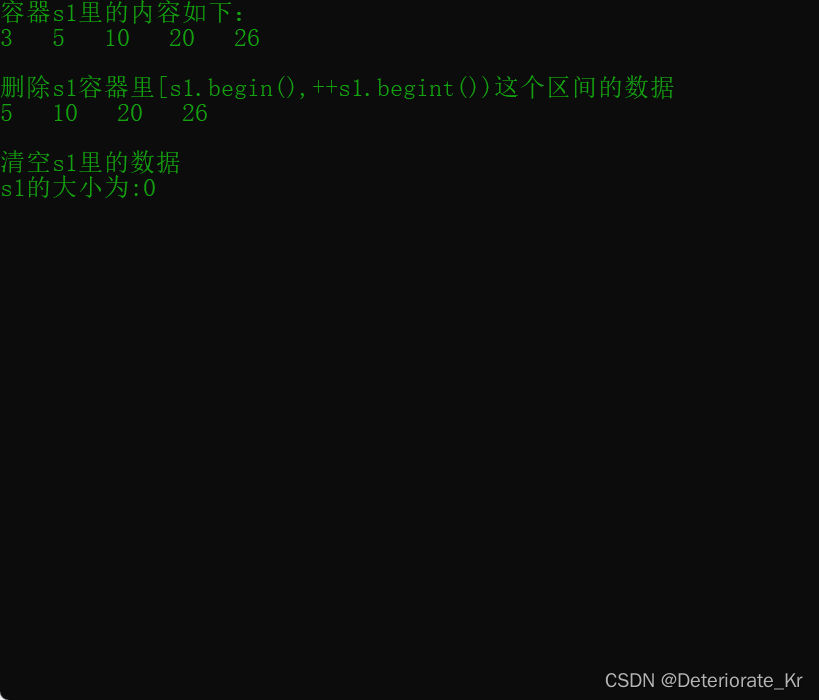
5 set查找和统计
功能描述:
- 对set容器进行查找数据以及统计数据
函数原型:
find(key);//查找key是否存在,若存在,返回该键的元素的迭代器;若不存在,返回set.end();set.end()不能解引用count(key);//统计key的元素个数,这个元素个数要么为0,要么为1
#include<iostream>
using namespace std;
#include<set>
void test01() {
set<int> s1;
s1.insert(11);
s1.insert(5);
s1.insert(0);
s1.insert(100);
s1.insert(100);
cout << "s1里的内容如下:" << endl;
// 遍历容器
for (set<int>::iterator it = s1.begin(); it != s1.end(); it++) {
cout << *it << " ";
}
cout << endl;
cout <<"s1的大小为:"<<s1.size() << endl;
cout << endl;
// 查找
cout << endl;
set<int>::iterator it1;
set<int>::iterator it2;
it1 = s1.find(100);
it2 = s1.find(500);
if (it1 == s1.end()) {
cout << "元素100未找到!!" << endl;
}
else {
cout << "元素100已找到!!" << endl;
}
if (it2 == s1.end()) {
cout << "元素500未找到!!" << endl;
}
else {
cout << "元素500已找到!!" << endl;
}
// 统计
cout<<endl<<endl<<"s1里等于100的数据有"<<s1.count(100)<<"个"<<endl;
}
int main() {
test01();
cin.get();
return 0;
}

总结:
- 查找 — find (返回的是迭代器)
- 统计 — count (对于set,结果为0或者1)
6 set和multiset的区别
区别:
- set不可以插入重复数据,而multiset可以
- set插入数据的同时会返回插入结果,表示插入是否成功
- multiset不会检测数据,因此可以插入重复数据
分析一下set容器的insert函数,从而验证set插入数据的同时会返回插入结果,表示插入是否成功。


通过查看insert函数的定义发现,他会返回一个pair类型。pair类型又是个结构体,里面有两个数。
解析:
-
pair代表对组类型。
对组:成对出现的一组数据 -
insert返回pair<iterator,bool>。
其中iterator(迭代器):代表插入的位置
bool(布尔变量):代表插入是否成功。true代表成功,false代表失败
这是multiset容器的insert函数,他只返回一个迭代器,并不检测数据。

#include<iostream>
using namespace std;
#include<set>
void test01() {
set<int> s1;
pair<set<int>::iterator, bool> ret1 = s1.insert(100);
// 注意使用对组里数据的方法
if (ret1.second) {
cout << "向set容器里第一次插入100成功!" << endl;
}
else {
cout << "向set容器里第一次插入100失败!" << endl;
}
pair<set<int>::iterator, bool> ret2 = s1.insert(100);
if (ret2.second) {
cout << "向set容器里第二次插入100成功!" << endl;
}
else {
cout << "向set容器里第二次插入100失败!" << endl;
}
cout << endl << endl;
// multiset
multiset<int> m1;
m1.insert(99);
m1.insert(100);
m1.insert(88);
m1.insert(66);
cout << "multiset容器里的数据如下:" << endl;
for (multiset<int>::iterator it = m1.begin(); it != m1.end(); it++) {
cout << *it << " ";
}cout << endl << endl;;
cout << "再向multiset容器里插入两个100后,容器里的数据为:" << endl;
m1.insert(100);
m1.insert(100);
for (multiset<int>::iterator it = m1.begin(); it != m1.end(); it++) {
cout << *it << " ";
}cout << endl;
cout << endl;
}
int main() {
test01();
cin.get();
return 0;
}
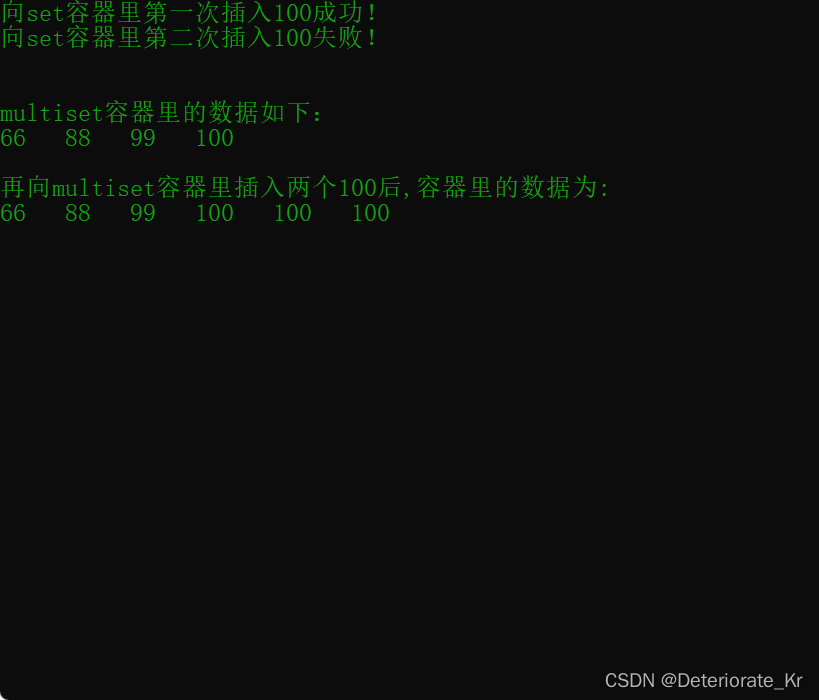
总结:
- 如果不允许插入重复数据可以利用set
- 如果需要插入重复数据利用multiset
multiset容器使用方法与set容器基本一致,但multiset没有插入数据检测,因此可以重复插入数据。它的insert函数只返回一个迭代器,表示插入数据的位置。
7 pair对组创建
功能描述:
- 成对出现的数据,利用对组可以返回两个数据
使用对组时不需要包含头文件
两种创建方式:
pair<type, type> p ( value1, value2 );pair<type, type> p = make_pair( value1, value2 );
#include<iostream>
using namespace std;
#include<string>
void test01() {
pair<string, int> ret1("asdasd",25);
cout << "第一种方式创建对组" << endl;
cout << "姓名:" << ret1.first << " " << "年龄:" << ret1.second << endl<<endl;
cout << "第二种方式创建对组" << endl;
pair<string, int> ret2=make_pair("ll;l,l,;", 35);
cout << "姓名:" << ret2.first << " " << "年龄:" << ret2.second << endl;
}
int main() {
test01();
cin.get();
return 0;
}
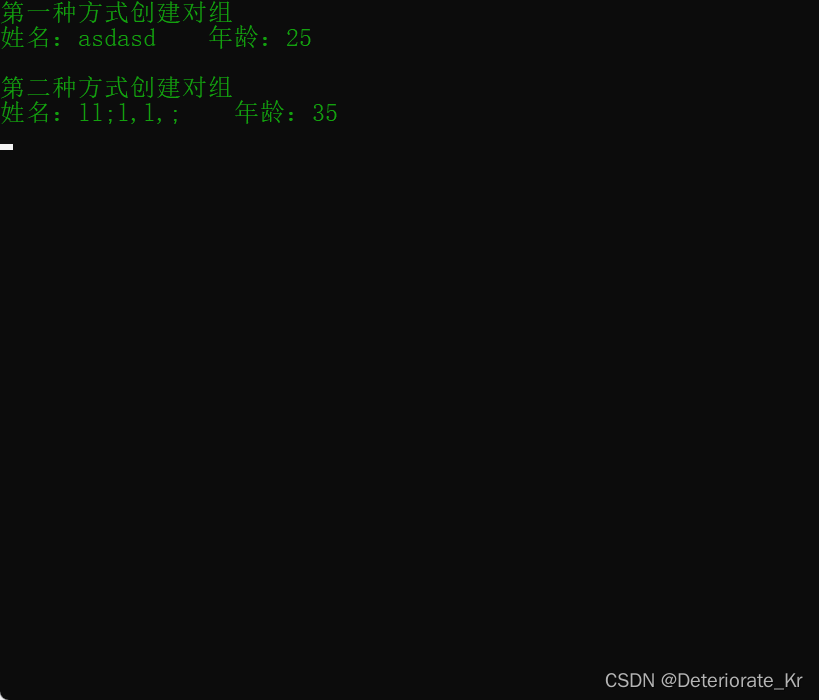
8 set容器排序
学习目标:
- set容器默认排序规则为从小到大,掌握如何改变排序规则
主要技术点:
- 利用仿函数,可以改变排序规则
8.1 内置类型指定排序规则
注意:set容器在插入数据时就会自动排序,所以我们要在插入数据前就得修改排序规则
利用仿函数(它包含在一个类里,类中有各个数据类型的仿函数)来指定排序规则,在set模板参数列表中再加一个参数

第二个参数有默认值,现在我们要给他赋值。
// 排序规则,利用仿函数,仿函数就是重载()
// 之不过仿函数要封装在类里
class Mycompare {
public:
// 第一个()是重载的意思,第二个()里放参数
// 注意最后要加一个const,这是C++最新规则规定的
bool operator()(int num1, int num2) const{
return num1 > num2;
}
};
// 然后把类名加到set参数列表里面去
set<int,Mycompare>s2;
s2.insert(10);
s2.insert(20);
s2.insert(40);
s2.insert(30);
s2.insert(5);
for (set<int>::iterator it = s2.begin(); it != s2.end(); it++) {
cout << *it << " ";
}
cout << endl;
综合:
#include<iostream>
using namespace std;
#include<set>
// 打印函数
void printSet(set<int> s) {
for (set<int>::iterator it = s.begin(); it != s.end(); it++) {
cout << *it << " ";
}
cout << endl;
}
// 排序规则,利用仿函数,他是个类
class Mycompare {
public:
// 第一个()是重载的意思
bool operator()(int num1, int num2) const{
return num1 > num2;
}
};
// 针对内置的数据类型
void test01() {
set<int>s1;
s1.insert(10);
s1.insert(20);
s1.insert(40);
s1.insert(30);
s1.insert(5);
cout << "没有修改排序规则的set容器s1:" << endl;
printSet(s1); cout << endl;
// 指定排序规则为从大到小
// 第二个参数直接输入类名
set<int,Mycompare>s2;
s2.insert(10);
s2.insert(20);
s2.insert(40);
s2.insert(30);
s2.insert(5);
cout << "将s2的排序规则修改为降序:" << endl;
for (set<int>::iterator it = s2.begin(); it != s2.end(); it++) {
cout << *it << " ";
}
cout << endl;
}
int main() {
test01();
cin.get();
return 0;
}

总结:利用仿函数可以指定set容器的排序规则
8.2 自定义数据类型指定排序规则
#include<iostream>
using namespace std;
#include<set>
#include<string>
// 打印函数
// 针对自定义的数据类型
class Person {
public:
string m_Name;
int m_Age;
Person(string name,int age):m_Name(name),m_Age(age){}
};
// 排序规则,利用仿函数,他是个类
class Mycompare {
public:
// 第一个()是重载的意思
// 按照年龄进行降序
bool operator()(Person p1, Person p2) const{
return p1.m_Age > p2.m_Age;
}
};
void test01() {
Person p1("asddsa", 25);
Person p2("waeeee", 36);
Person p3("男枪", 46);
Person p4("NAVI", 76);
set<Person,Mycompare> s1;
s1.insert(p1);
s1.insert(p2);
s1.insert(p3);
s1.insert(p4);
// 看看他默认是如何排序的
// 这样子肯定不能输出,他怎么知道按照哪个规则排序呢???
// 所以自定义类型必须指定排序规则
for (set<Person>::iterator it = s1.begin(); it != s1.end(); it++) {
cout << "姓名:" << it->m_Name << " " << "年龄:" << it->m_Age << endl;
}
cout << endl;
}
int main() {
test01();
cin.get();
return 0;
}
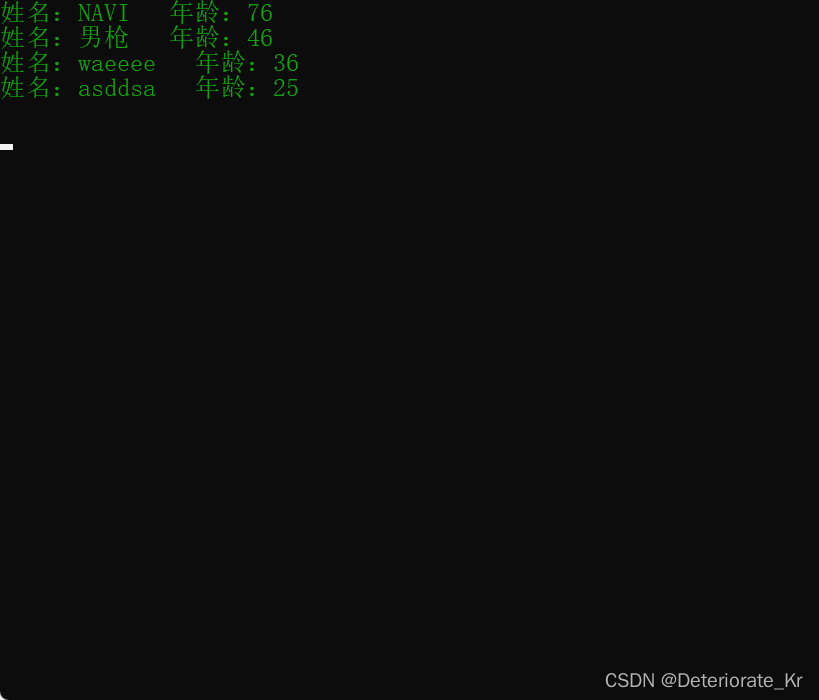





















 6193
6193











 被折叠的 条评论
为什么被折叠?
被折叠的 条评论
为什么被折叠?








